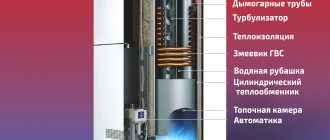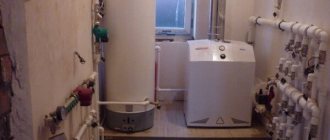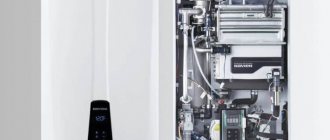Home / Boiler rooms
Back
Published: 10/22/2019
Reading time: 3 min
0
10996
A boiler room is a complex engineering system consisting of a large number of mechanisms and components designed to generate thermal energy for industrial needs and heat supply to residential and public buildings.
The boiler room at the enterprise, as a source of heat, is closely connected with utility networks located both on its territory and outside.
- 1 Types of industrial boiler plants
- 2 Operating principle
- 3 Boiler equipment
- 4 Smoke exhaust systems
- 5 Requirements for industrial gas boiler houses
Types of industrial boiler plants
Industrial gas boilers are classified according to power into low, medium and high power units. The first group includes water heating, steam and condensing generators with a power of up to 20 MW and an efficiency of up to 96%. They are usually used for heat supply to small enterprises.
For integrated heat supply with the delivery of heating, hot water supply and ventilation loads, enterprises install boiler houses with a total capacity of up to 100 MW.
Such equipment is installed in large district boiler houses, capable of providing heat not only to industrial, but also to residential consumers. To supply hot water and steam to large factories and regional city heating network enterprises, gas boilers with a capacity of 600 MW or more are used.
According to their purpose, gas boiler houses at the enterprise are divided into:
- Heating – for centralized supply for the needs of heating, ventilation and hot water supply for domestic and industrial consumers;
- Industrial – for technological supply of heat in the form of steam and hot water to industrial enterprises.
- Heating and production – for integrated heat supply to heating systems and technological processes.
- According to the scheme, boiler houses are divided into a closed type, when all network water through the main heating networks returns back to the source, and an open system, when part of the hot coolant is consumed for technological or domestic needs.
- In industry, technological consumers of thermal energy in the form of steam are paper, chemical and metallurgical production, petrochemical complexes, rectification and chemical reactors, sorption-desorption units for the gas purification process, galvanic lines and devices for laminating surfaces.
A promising direction has become the installation of combined boiler rooms, steam-hydrogen boiler rooms, autonomous block modules, and rooftop heat supply systems.
Good mobile systems are considered to be block-modular, assembled at the factory and transported to the installation site in assembled form.
On-site launch of such systems takes place according to an accelerated turnkey program, taking into account that installation and commissioning work is carried out in production.
The best known manufacturers and models: characteristics and prices
There are many versions of the best industrial boilers published online, since the choice on the market is very wide. However, in many ratings, the following installations for the production of heat and steam are present at various locations.
Buderus Logano SK655/SK755
Two lines of universal boilers: SK655 with a power range from 120 to 360 kW and SK755 - from 420 to 1,850 kW. Low-temperature water heating (up to 110 °C) units running on diesel fuel, liquefied and natural gas. Minimal heat loss and almost complete combustion of fuel bring efficiency to 93% and minimize emissions into the atmosphere. Used in public utilities and thermal power plants. Manufacturer – Belgium.
Cost: 180,000-1,300,000 rubles.
Bosch Unimat UT-M
Universal fire-tube water heating boilers of a three-pass design, operating on gas and diesel fuel. The series is represented by capacities from 750 to 1,920 kW, produces high-temperature coolant (up to 190 ° C) when retrofitted with an economizer and a condensing heat exchanger, the efficiency can be increased to 105%. They are used in city and regional boiler houses, they can work in cascade and for technological purposes in industrial enterprises. Developed in Germany, production in Russia.
Viessmann Vitoplex 100
German hot water boilers with a power from 110 to 2,000 kW, two-pass design reaches an efficiency of 95%. Innovative burners allow you to burn liquid fuel (waste oil) and gas with virtually no emissions into the atmosphere. Coolant temperature up to 110°C. Small size, simple operation and maintenance-friendly design. Suitable for medium-sized boiler houses. The price depends on the configuration.
Cost: 410,000-2,900,000 rubles.
ACV R 200
Solid fuel wood boiler, produces a power of 200 kW, non-volatile, with a three-pass open combustion chamber. It also effectively burns peat, fuel briquettes and pellets with an efficiency of 80%; when retrofitted, it can operate on liquid fuel (waste fuel) and gas. The coolant temperature is 90°C. Convenient for heating small production facilities (heats up to 1,600 m2) away from gas mains, very resistant to burnout (thick-walled). Manufacturer: Belgium.
Cost: 410,000-1,100,000 rub.
The market for industrial boilers is filled not only with imported developments; there are domestic manufacturers who produce equipment that is less efficient in some respects, but is more adapted to our fuel realities.
Principle of operation
Gas industrial boiler houses, regardless of their power, practically have the same control scheme and operating principle. Structural differences are observed only in water-water and steam-water boilers. Boiler installations of industrial enterprises consist of main and auxiliary equipment.
The main ones include the boiler itself and the devices enclosed in its body - pipe packages, separators, manifolds, drums. Auxiliary equipment includes a gas burner, pumps, fans, smoke exhausters, fittings, fittings, and an automatic control and safety system.
In hot water boilers, water is heated to a maximum temperature of 150 C as a result of fuel combustion and heat transfer from flue gases to the main coolant. The panels are made gas-tight to increase heat transfer; for this purpose, steel pipes are welded together.
After combustion, the flue gases of the water, under the influence of the vacuum created by the smoke exhauster, enter the convector block, where the pipes are mounted in a checkerboard pattern, which increases the heating surface and the rate of transfer of water to the network coolant.
In a hot water boiler, water moves forcibly; the speed of movement is determined by network pumps, which provide the necessary performance and pressure. Water enters and exits through the boiler manifold.
The operating principle of a steam boiler differs from a hot water boiler. The movement of water in its internal circuit occurs due to the natural circulation of cold and heated steam-water media.
As a result of the heat transfer process, saturated or superheated steam is obtained at the boiler outlet. To collect it, modern boilers install drums and separation devices in the upper drum to remove the smallest particles of boiler water from the steam.
Network water does not circulate through the steam boiler; it is fed with chemically purified feed water using special feed pumps. The network water circuit does not intersect with the feed water, and it is heated in steam-water network heat exchangers, in which steam from the boiler through a pipe system heats the supply coolant to a maximum temperature of 150 C.
Safety of use
Industrial gas devices are convenient and safe to use. There are certain requirements for their operation, the mandatory implementation of which will reduce the risk of industrial accidents and accidents. The gas burner may go out, which can even lead to a gas explosion. Such situations may arise if:
- the pressure in the system does not meet certain standards;
- the power was suddenly cut off;
- the draft in the chimney has stopped.
To avoid these situations, manufacturers install built-in security systems in manufactured models. Now on the gas boiler market you can purchase modern equipment with self-diagnosis systems, also equipped with thermostats that protect against water overheating, pump blocking, and a controller that regulates the intensity of the flame.
Apart from these benefits, there is another important feature. In gas installations, the anti-scale protection system is activated. This happens thanks to special fuses built into the heating circuit. Multifunctional gas boilers are more expensive equipment, but this increases their stability and reliability, and most importantly, warranty and safety.
Boiler equipment
Boilers are the main element of the organization and implementation of the steam power cycle of the heat supply system. The body of low-power low-pressure boilers is made of cast iron, and the body of medium and high-pressure boilers is made of boiler steel.
In order to correctly select the type and number of boilers, technical and economic calculations are performed, taking into account the following factors:
- Maximum and minimum heat load of consumers in winter and summer.
- Distance and diameters of heating networks broken down to each consumer.
- Quality of water and fuel.
- Level of automation of a gas boiler room.
- Boiler room dimensions.
The next most important element of the boiler unit is the burner device, where the process of mixing gas and air and igniting the gas-air mixture to form a torch takes place. The combustion process itself takes place in the combustion chamber.
The choice of boiler based on the heat output of the burner must correspond to its power, taking into account the emergency reserve. Good Lemax gas equipment can be purchased in Ishim.
The operation of the burner is ensured by the gas equipment of the boiler room: gas distribution unit or hydraulic fracturing unit, regulators, filters, control devices and a security system. All elements of the gas industry are classified as high-risk objects; their operation is regulated by SNiP II-35-76 “Boiler installations”.
Classification by type of accommodation
Wall-mounted water heating boilers have a relatively small weight, unlike floor-standing models
Water heating devices, depending on power and design, have different weights and sizes. This largely determines the place where they can be installed.
Floor products are characterized by significant weight and dimensions. It is impossible to hang them precisely because of these factors, since not every load-bearing surface can withstand such a load. The advantage is that such devices are more reliable and functional.
Wall-mounted boilers are compact and light in weight. Their development was initially aimed at ensuring that the products could be installed in tight spaces - kitchen, bathroom, basement. Due to size restrictions, such boilers are not designed for high power; the close arrangement of parts makes them difficult to service and reduces the level of reliability.
Smoke exhaust systems
The boiler room smoke ventilation system is used to create a vacuum in the gas path of the boiler unit and remove flue gases from the boiler into the atmosphere. It consists of a smoke exhauster, a fan, chimneys and a chimney.
Instrumentation and safety automation (ICS) are designed to monitor the operation of the installation according to regime maps, regulate the boiler load and ensure safe operation of the equipment.
In all modern boiler units, the installation of instrumentation and control equipment is a mandatory requirement, in accordance with the norms and regulations for the operation of boiler installations.
Boiler equipment protection is triggered by activating sound and light alarms to alert operating personnel.
Instrumentation and automation protection parameters:
- separation of the torch in the boiler;
- high pressure of steam, gas, water;
- low vacuum in the boiler furnace;
- power outage;
- low water level in the boiler;
- low pressure of air, water and gas.
When the alarm is triggered, after a short time, if the operating personnel have not corrected the failure, the boiler is stopped by the instrumentation and control system, through forced shutdown of the gas supply to the furnace.
Where does pure hydrogen come from?
Note to the owner
“To attract attention to their products, some hydrogen boiler manufacturers make references to some kind of “secret catalyst” or to the use of “Brown gas” in their devices.” For example, you can extract hydrogen from methane gas, where there are as many as 4 atoms of hydrogen! But why? Methane itself is a flammable gas, so why waste additional energy to produce pure hydrogen? Where is the energy efficiency? Therefore, hydrogen is most often extracted from water, which, as everyone knows, cannot burn, using the electrolysis method. In its most general form, this method can be described as the splitting of water molecules into hydrogen and oxygen under the influence of electricity
In its most general form, this method can be described as the splitting of water molecules into hydrogen and oxygen under the influence of electricity
For example, you can extract hydrogen from methane gas, where there are as many as 4 atoms of hydrogen! But why? Methane itself is a flammable gas, so why waste additional energy to produce pure hydrogen? Where is the energy efficiency? Therefore, hydrogen is most often extracted from water, which, as everyone knows, cannot burn, using the electrolysis method. In its most general form, this method can be described as the splitting of water molecules into hydrogen and oxygen under the influence of electricity.
Electrolysis has long been known and widely used to produce pure hydrogen. In practice, not a single industrial hydrogen boiler, at least for now, can do without an electrolysis installation or electrolyzer. Everything would be fine, but this installation requires electricity. So, a hydrogen boiler must necessarily consume energy. The question is, what are these energy costs?
Electrolysis process diagram
All the talk about the “heat of combustion” of hydrogen takes us a little away from this issue, and yet it is the most important. So, a hydrogen boiler can be beneficial in the only case - the thermal energy it produces must be higher than that expended on the operation of the boiler.
Requirements for industrial gas boiler houses
Gas boiler houses are fire hazardous facilities; they are subject to special requirements at the stages of design, installation and operation. The basic requirements are enshrined in SNiP II-35 - “Boiler installations”.
Requirements for pumps are specified in SP 89.13330.2012. Water and steam must comply with GOST 20995-75, 2761-84, and the chemical water treatment system must comply with SNiP 2.04.02-84 “Water Supply”. More detailed information on the requirements and rules can be found in the book “Boiler installations of industrial enterprises” (L.N. Sidelkovsky, V.N. Yurenev).
Industrial boiler boiler boilers are installed in a separate building, whose fire resistance is determined by production requirements. For installation of large-sized elements and components of the boiler, installation openings must be provided.
The design and construction of industrial boiler houses is carried out taking into account existing building plans and utilities in the area of the proposed construction.
The project should include a boiler room, a pump room, a fuel facility, premises for chemical water treatment and instrumentation.
Coolant for boiler
In many ways, installation with connection to the heating system itself plays a large role in the selection of the installation.
The key element in the systems is the coolant, which is received by the boiler, subjected to heating, and then released to flow through pipes and radiators. At such points of consumption, the heated agent gives off heat directly to the radiators and pipes, which heat the room. Industrial models can be universal in terms of receiving and processing a specific coolant with thermal energy. But for industrial use, there are often boilers that can accept only one type of coolant. The choice is usually presented between three main types of liquid distillation medium:
- Water.
- Antifreeze.
- Propylene glycol.
Inhibitor mixtures are also added to such liquids to maximally neutralize the aggressiveness of media flowing through metal pipes. This is done to avoid metal corrosion. When using plastic pipes, such means are necessary to eliminate scale. This is especially true for water or steam.
DIY making
It’s easy to make a simple hot water boiler yourself. Here's what you need to consider:
- The choice of firebox material should take into account what type of fuel you plan to use. Coal is characterized by a much higher combustion temperature than wood, so sheets for making a coal boiler firebox should be thicker - thin steel will quickly burn out.
- The ideal material is special heat-resistant boiler steel. In second place is alloyed heat-resistant steel with additions of chromium and molybdenum, for example, grades 12ХМ or 12Х1МФ. If you plan to use ordinary steel, then it should have a grade lower than steel 35. In steels of higher grades, when heated, a hardening effect occurs, as a result of which they become brittle.
Kits consisting of a fan, a temperature sensor and a controller are available for sale (for example, from the Polish company KG Elektronik), with the help of which it is easy to organize forced air supply into the firebox (see above for the description of the operation of a boiler with a fan).
Lifetime
The service life of industrial gas boilers, if the manufacturer’s requirements are met, is long and reaches 20 years. The minimum value is 10 years. The service life depends on the type of equipment and before the first cleaning of internal contamination is about 3,000 hours.
3 years must pass between major repairs. The total service life is 10 years if the output does not exceed 4.65 MW. This takes into account the annual work duration of about 3,000 hours.
If the productivity reaches 35 MW, the service life of an industrial gas boiler will be 15 years. The term increases to 20 years with increasing productivity above 35 MW.
Steam units
Representatives of this category, as the name suggests, are designed to produce steam. Industrial-type units produce it for technical support needs. In particular, such equipment is used in woodworking enterprises. Steam exposure allows you to maintain optimal humidity parameters in drying chambers. In medicine, industrial steam boilers are used to sterilize work clothing and work equipment, and agriculture uses them in the production of fertilizers and animal feed. It is important to separate saturated and superheated steam. In the industries listed above, saturated coolant is used. Superheated steam, in turn, is used in special turbines of power plants. Therefore, boilers of this type are also called energy boilers. Often, units that produce superheated steam are used in conjunction with generators of saturated thermal media. This nuance allows us to classify power plants as industrial boilers.
Step-by-step production of a solid fuel boiler. Subtleties and nuances
You will not be able to make the most economical homemade solid fuel boiler, but you can create a heating apparatus that is quite suitable for heating and hot water supply. The fact is that the assembly of industrial products is carried out on high-precision industrial equipment from specially selected materials in compliance with technological parameters. Each factory boiler model is based on accurate thermal calculations. The possibilities of working at home are incomparably more modest than in industrial conditions, therefore, when choosing a model to be manufactured, one must proceed from existing realities, including one’s personal potential as an installer.
Tools and materials
Having a drawing and specification of the heating unit, you can determine the list of necessary tools. Whether you want to make a large boiler or plan to assemble a small solid fuel heating device for your dacha with your own hands, the list of accessories will be approximately the same.
Tool kit for self-production of a solid fuel heating unit
To work you will need the following tools and accessories:
- welding machine;
- small grinder with cutting and grinding discs (safety glasses);
- electric drill with metal drills;
- gas keys No. 1, 2;
- hammer;
- a set of open-end or ring wrenches and screwdrivers;
- pliers;
- 90 degree square
The main material in production is steel, the thickness of which for the boiler must be at least 5 mm, for grates - from 7 mm.
In addition, you will need:
- steel corner 50x50 - for the boiler frame;
- sheet stainless steel - if there is a storage tank in the design;
- thick-walled steel pipes with a diameter of 32-50 mm - for the manufacture of a coil heat exchanger.
A complete list of materials and their consumption is prepared in advance on the basis of technical drawings.
Manufacturing of the housing and heat exchanger
The boiler body, which often acts as a combustion chamber, is the basis of the entire structure. To reduce the deformation of the walls under the influence of high temperature, the enclosing structures of the firebox are made in two layers with a backfill between the layers of dry sifted sand, which plays the role of a geometry fixator. The outer and inner shells of the firebox are made of frames, which also increases the rigidity of the structure. In addition, to increase the strength of the combustion chamber wall, the outside can be sheathed with a steel angle or profile in the form of stiffening ribs.
Application of electric boilers in industry
The high price of electricity prevents the widespread use of electric boilers in everyday life. There is no doubt that this price has been raised artificially to make it possible to sell gas. After all, a well that has started to work is not easy to plug. Therefore, as long as gas is produced, one cannot hope for a reduction in prices for electricity, pellets, firewood and coal. Due to the high price of electricity for enterprises, industrial electric heating boilers are used extremely rarely. They are used as a reserve to provide heating in case of any unforeseen circumstances.
Solid fuel
This type of industrial units comes in second place. Many experts believe that they are the future. Coal deposits in Russia are huge, peat and firewood are no less, so the likelihood that solid fuel boilers will take a leading position is very high.
In addition, this type of equipment has high efficiency, plus maximum coolant temperature production. True, it was not without its shortcomings. First of all, it is necessary to note the large (sometimes simply huge) dimensions of water heating installations.
In addition, to maintain their performance, it is necessary to maintain large reserves of fuel, and these are warehouses, transport, and staff, which increases the cost of the generated heat. And lastly, solid fuel industrial boilers cannot be fully automated.
All other types of industrial units are less popular. Some due to the high cost of fuel, some due to the complexity of operation and maintenance.
Pyrolysis combustion boilers
Among the numerous options with semi-automatic fuel combustion, gas generator or pyrolysis boilers are distinguished. Such boilers are designed to burn only one type of fuel - dry wood, which makes it possible to organize a system with a consistently high efficiency of up to 85%. The pyrolysis combustion method is designed to extract heat as efficiently as possible: in addition to burning the fuel itself, gases emanating from the burning of wood are burned. Firewood in a pyrolysis solid fuel boiler with a water circuit does not burn with a “bright flame”, but gradually smolders. Automation and a forced-air fan with dosing of primary and secondary air are responsible for uniform smoldering of the fuel. Maximum burning of wood in this mode allows you to make the system the most environmentally friendly; afterburning of gases significantly reduces the volume of emissions through the chimney. Gas generator models do not leave traces or soot outside the house.
Introduced about 30 years ago, long-burning gas generator boilers remain very expensive equipment. The price of the boiler can be justified by solving numerous heating problems. If the regular supply of dry wood is not difficult or difficult, financial capabilities allow and you need to organize a highly efficient environmentally friendly heating system, then a pyrolysis boiler is an ideal option.











